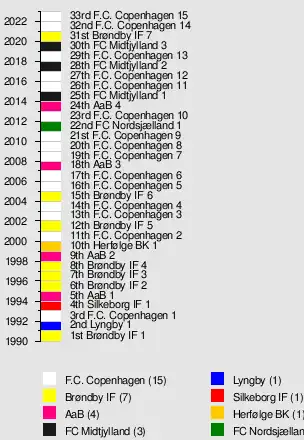Danish Superliga
The Danish Superliga (Danish: Superligaen, pronounced [ˈsuˀpɐliːˌkɛˀn̩]) is the current Danish football championship tournament, and administered by the Danish Football Association. It is the highest football league in Denmark and is currently contested by 12 teams each year, with two teams relegated.
 | |
| Founded | 1991 |
|---|---|
| First season | 1991 |
| Country | Denmark |
| Confederation | UEFA |
| Number of teams | 12 |
| Level on pyramid | 1 |
| Relegation to | Danish 1st Division |
| Domestic cup(s) | Danish Cup |
| International cup(s) | UEFA Champions League UEFA Europa League UEFA Europa Conference League |
| Current champions | Copenhagen (15th title) (2022–23) |
| Most championships | Copenhagen (15 titles) |
| Most appearances | Rasmus Würtz (452) |
| Top goalscorer | Morten Rasmussen (145) |
| TV partners | Domestic Viaplay Group (TV3+, TV3 Sport, TV3 MAX) Discovery Networks Denmark (Canal 9, Eurosport 2) International Eleven Sports OneFootball |
| Website | |
| Current: 2023–24 Danish Superliga | |
| Danish football league structure |
|---|
| Superliga (Tier 1) |
| 1st Division (Tier 2) |
| 2nd Division (Tier 3) |
| 3rd Division (Tier 4) |
| Denmark Series (Tiers 5) |
| Copenhagen Series – Funen Series – Jutland Series – Zealand Series (Tiers 6) |
| Series 1 (Tiers 7) |
| Series 2 (Tiers 8) |
| Series 3 (Tiers 9) |
| Series 4 (Tiers 10) |
| Series 5 (Tiers 11) |
History
Founded in 1991, the Danish Superliga replaced the Danish 1st Division as the highest league of football in Denmark. From the start in 1991, 10 teams were participating. The opening Superliga season was played during the spring of 1991, with the ten teams playing each other twice for the championship title. From the summer of 1991, the tournament structure would stretch over two calendar years. The 10 teams would play each other twice in the first half of the tournament. In the following spring, the bottom two teams would be cut off, the points of the teams would be cut in half, and the remaining eight teams would once more play each other twice, for a total of 32 games in a season.
This practice was abandoned before the 1995–96 season, when the number of teams competing was increased to 12, playing each other thrice for 33 games per Superliga season. For the first season of this new structure, Coca-Cola became the name sponsor of the league, which was then named Coca-Cola Ligaen. After a single season under that name, Faxe Brewery became sponsors and the league changed its name to Faxe Kondi Ligaen. Before the 2001–02 season, Scandinavian Airlines System (SAS) became the head sponsor, and the name of the tournament changed to SAS Ligaen. From January 2015 the Danish Superliga is known as Alka Superliga, as the Danish insurance company Alka became name sponsor.[1]
Logos used for naming rights agreements for the league:



 Superligaen
Superligaen
(2010–11 until 31 Dec 2014)
No league sponsor.svg.png.webp)
 Superligaen
Superligaen
2018–19
No league sponsor
Structure
From 1996 through 2016, the league included 12 clubs which played each other three times. The two teams with the fewest points at the end of the season were relegated to the Danish 1st Division and replaced by the top two teams of that division. During this era, each team played every other team at least once at home and once away plus once more either at home or away. The top six teams of the previous season played 17 matches at home and 16 away while the teams in 7th to 10th place plus the two newly promoted teams played 16 matches at home and 17 away.
Following the 2015–16 season, the league was expanded to 14 teams, accomplished by relegating only the last-place finisher in that season and promoting the top three teams from the 1st division. The 2016–17 season was the first for the new league structure. It began with the teams playing a full home-and-away schedule, resulting in 26 matches for each team. At that time, the league split into a six-team championship playoff and an eight-team qualifying playoff. All teams' table points and goals carry over fully into the playoffs.
In the championship playoff, each team plays the others home and away again. The top team at the end of the playoff is Superliga champion and enters the Champions League in the second qualifying round. The second-place team enters the Europa League in the first qualifying round. The third-place team advances to a one-off playoff match for another Europa League place. If the winner of the Danish Cup finishes in the top three, the match will instead involve the fourth-place team.
The qualifying playoff is split into two groups, with the teams that finished the regular season in 7th, 10th, 11th, and 14th in one group and those finishing 8th, 9th, 12th, and 13th in the other. Each group plays home-and-away within its group. The top two teams from each group then enter a knockout tournament, with each match over two legs. If the Danish Cup winner is among the top two finishers in either playoff group, it is withdrawn from the knockout playoff and its opponent automatically advances to the tournament final. The winner of that tournament faces the third-place (or fourth-place) team from the championship playoff in a one-off match, with the winner entering the Europa League in the first qualifying round.
The bottom two teams from each group then contest a relegation playoff with several steps, centered on a separate four-team knockout playoff, also consisting totally of two-legged matches:
- The third-placed teams in each group play over two legs, with the winners remaining in the Superliga and the losers advancing to a playoff final against the third-place team from the 1st Division.
- The bottom teams in each group play over two legs, with the winners advancing to a play-off final against the second-place team from the 1st Division, and the losers dropping to next season's 1st Division.
- The winners of each play-off final play in the next season's Superliga.
In the 2019–20 season, the number of teams was reduced from 14 to 12 teams. It began with all 12 teams playing a full home-and-away schedule, resulting in 22 matches for each team. At that time, the league split into a six-team championship playoff and a six-team qualifying playoff. All teams' points and goals carried over fully from the regular season into the playoffs. In both playoff groups, six teams play a full home-and-away schedule, resulting in ten matches (32 for the full season). The two bottom teams in the qualifying playoff are relegated to 1st Division, while the team finishing 7th plays against the lowest placed team from the Championship playoff, who failed to qualify directly to European Football, in a single match, to decide the final European spot from Denmark.
Teams
Current teams (2023–24)
| Club | Finishing position last season |
First season in top division |
First season of current spell in top division |
|---|---|---|---|
| AGF | 3rd | 1918–19 | 2015–16 |
| Brøndby | 5th | 1982 | 1982 |
| Copenhagen | 1st | 1992–93 | 1992–93 |
| Hvidovre IF | 2nd in 1st Division | 1965 | 2023–24 |
| Lyngby | 10th | 1980 | 2022–23 |
| Midtjylland | 7th | 2000–01 | 2000–01 |
| Nordsjælland | 2nd | 2002–03 | 2002–03 |
| OB | 8th | 1927–28 | 1999–00 |
| Randers | 6th | 1970 | 2011–12 |
| Silkeborg | 9th | 1988 | 2021–22 |
| Vejle Boldklub | 1st in 1st Division | 1956-57 | 2023–24 |
| Viborg | 4th | 1981 | 2021–22 |
Winners
 |
Seasons
| Season | Champions | Performance | |||||||
|---|---|---|---|---|---|---|---|---|---|
| Pts | Pld | W | D | L | GF | GA | GD | ||
| 1991 | Brøndby IF | 26 | 18 | 10 | 6 | 2 | 26 | 15 | +11 |
| 1991–92 | Lyngby BK | 32[2] | 14 | 9 | 2 | 3 | 22 | 7 | +15 |
| 1992–93 | F.C. Copenhagen | 32[2] | 14 | 8 | 3 | 3 | 31 | 23 | +8 |
| 1993–94 | Silkeborg IF | 31[2] | 14 | 8 | 2 | 4 | 23 | 15 | +8 |
| 1994–95 | AaB | 31[2] | 14 | 7 | 4 | 3 | 30 | 13 | +17 |
| 1995–96 | Brøndby IF | 67 | 33 | 20 | 7 | 6 | 71 | 32 | +39 |
| 1996–97 | Brøndby IF | 68 | 33 | 20 | 8 | 5 | 64 | 39 | +25 |
| 1997–98 | Brøndby IF | 76 | 33 | 24 | 4 | 5 | 81 | 33 | +48 |
| 1998–99 | AaB | 64 | 33 | 17 | 13 | 3 | 65 | 37 | +28 |
| 1999–2000 | Herfølge BK | 56 | 33 | 16 | 8 | 9 | 52 | 49 | +3 |
| 2000–01 | F.C. Copenhagen | 63 | 33 | 17 | 12 | 4 | 55 | 27 | +28 |
| 2001–02 | Brøndby IF | 69 | 33 | 20 | 9 | 4 | 74 | 28 | +46 |
| 2002–03 | F.C. Copenhagen | 61 | 33 | 17 | 10 | 6 | 51 | 32 | +19 |
| 2003–04 | F.C. Copenhagen | 68 | 33 | 20 | 8 | 5 | 56 | 27 | +29 |
| 2004–05 | Brøndby IF | 69 | 33 | 20 | 9 | 4 | 61 | 23 | +38 |
| 2005–06 | F.C. Copenhagen | 73 | 33 | 22 | 7 | 4 | 62 | 27 | +35 |
| 2006–07 | F.C. Copenhagen | 76 | 33 | 23 | 7 | 3 | 60 | 23 | +37 |
| 2007–08 | AaB | 71 | 33 | 22 | 5 | 6 | 60 | 38 | +22 |
| 2008–09 | F.C. Copenhagen | 74 | 33 | 23 | 5 | 5 | 67 | 26 | +41 |
| 2009–10 | F.C. Copenhagen | 68 | 33 | 21 | 5 | 7 | 61 | 22 | +39 |
| 2010–11 | F.C. Copenhagen | 81 | 33 | 25 | 6 | 2 | 77 | 29 | +48 |
| 2011–12 | FC Nordsjælland | 68 | 33 | 21 | 5 | 7 | 49 | 22 | +27 |
| 2012–13 | F.C. Copenhagen | 65 | 33 | 18 | 11 | 4 | 62 | 32 | +30 |
| 2013–14 | AaB | 62 | 33 | 18 | 8 | 7 | 60 | 38 | +22 |
| 2014–15 | FC Midtjylland | 71 | 33 | 22 | 5 | 6 | 64 | 34 | +30 |
| 2015–16 | F.C. Copenhagen | 71 | 33 | 21 | 8 | 4 | 62 | 28 | +34 |
| 2016–17 | F.C. Copenhagen | 84 | 36 | 25 | 9 | 2 | 74 | 20 | +54 |
| 2017–18 | FC Midtjylland | 85 | 36 | 27 | 4 | 5 | 80 | 39 | +41 |
| 2018–19 | F.C. Copenhagen | 82 | 36 | 26 | 4 | 6 | 86 | 37 | +49 |
| 2019–20 | FC Midtjylland | 82 | 36 | 26 | 4 | 6 | 61 | 29 | +32 |
| 2020–21 | Brøndby IF | 61 | 32 | 19 | 4 | 9 | 58 | 38 | +20 |
| 2021–22 | F.C. Copenhagen | 68 | 32 | 20 | 8 | 4 | 56 | 19 | +37 |
| 2022–23 | F.C. Copenhagen | 59 | 32 | 18 | 5 | 9 | 61 | 35 | +26 |
Relegations
Notable players
Top goalscorers
All-Time topscorer(s)
The 10 most scoring players throughout the history of the Superliga. Latest update 30 December 2022.
Rank Topscorer(s) Goals Club(s) 1. Morten "Duncan" Rasmussen 145 AGF, Brøndby IF, AaB, FC Midtjylland 2. Søren Frederiksen 139 Silkeborg IF, Viborg FF, AaB 3. Peter Møller 135 AaB, Brøndby IF, FC København 4. Heine Fernandez 126 AB, FC København, Silkeborg IF, Viborg FF 5. Steffen Højer 124 OB, Viborg FF, AaB 6. Frank Kristensen 109 FC Midtjylland, Ikast fS, Randers FC 7. Peter Graulund 107 AGF, Brøndby IF, Vejle BK 8. Søren Andersen 101 AGF, OB, AaB 9. Nicklas Helenius 93 AaB, Silkeborg IF, OB, AGF 10. Dame N'Doye 90 FC København
Most capped players
Most capped foreign players
Attendances
| Season | Average | Total | Max | Min |
|---|---|---|---|---|
| 1991 | 3,937 | 354,348 | 13,935 | 712 |
| 1991–92 | 4,428 | 646,510 | 16,500 | 1,014 |
| 1992–93 | 5,023 | 733,299 | 22,862 | 484 |
| 1993–94 | 4,739 | 691,855 | 26,679 | 475 |
| 1994–95 | 5,930 | 865,755 | 36,623 | 487 |
| 1995–96 | 5,689 | 1,126,414 | 39,640 | 704 |
| 1996–97 | 5,318 | 1,052,922 | 28,491 | 585 |
| 1997–98 | 5,519 | 1,092,688 | 33,124 | 939 |
| 1998–99 | 4,974 | 984,874 | 37,940 | 180 |
| 1999–2000 | 5,838 | 1,155,917 | 28,818 | 1,493 |
| 2000–01 | 5,837 | 1,155,662 | 40,281 | 1,003 |
| 2001–02 | 5,727 | 1,133,920 | 40,186 | 314 |
| 2002–03 | 7,307 | 1,446,752 | 40,254 | 800 |
| 2003–04 | 7,980 | 1,580,011 | 41,005 | 1,011 |
| 2004–05 | 8,589 | 1,700,532 | 40,654 | 843 |
| 2005–06 | 7,957 | 1,575,399 | 41,201 | 1,307 |
| 2006–07 | 8,108 | 1,605,367 | 40,463 | 1,799 |
| 2007–08 | 8,499 | 1,682,791 | 32,153 | 1,035 |
| 2008–09 | 8,815 | 1,745,308 | 32,856 | 1,609 |
| 2009–10 | 8,315 | 1,646,405 | 30,191 | 707 |
| 2010–11 | 7,049 | 1,395,616 | 28,387 | 1,017 |
| 2011–12 | 7,103 | 1,406,462 | 25,651 | 1,059 |
| 2012–13 | 6,760 | 1,338,465 | 33,215 | 0 [lower-alpha 1] |
| 2013–14 | 7,929 | 1,570,027 | 32,846 | 1,656 |
| 2014–15 | 6,932 | 1,372,511 | 32,526 | 1,201 |
| 2015–16 | 7,253 | 1,436,188 | 29,178 | 1,327 |
| 2016–17 | 6,002 | 1,500,380 | 26,686 | 1,044 |
| 2017–18 | 5,880 | 1,469,980 | 28,410 | 568 |
| 2018–19 | 6,581 | 1,618,965 | 33,134 | 1,012 |
| 2019–20 | 4,764 | 1,152,832 | 29,310 | 0 [lower-alpha 2] |
| 2020–21 | 1,193 | 229,136 | 10,966 | 0 [lower-alpha 3] |
| 2021–22 | 8,636 | 1,658,078 | 35,463 | 1,702 |
| 2022–23 | 10,289 | 1,975,454 | 35,820 | 2,507 |
- Brøndby IF got a two matches ban on spectators due to unrest at a cup game against FC København.[5]
- Due to the COVID-19 pandemic some games were played without spectators and some games were played with a reduced amount allowed.[6]
- Due to the COVID-19 pandemic some games were played without spectators and some games were played with a reduced amount allowed.[7]
Notes
- "Officielt: Superligaen bliver til Alka Superligaen". Archived from the original on 22 December 2014. Retrieved 2 November 2014.
- Tally includes points carried over from the first half of the season.
- "Spilletid, all-time". SuperStats. Archived from the original on 25 July 2023. Retrieved 25 July 2023.
- "UDLÆNDINGE MED FLEST SPILLEDE KAMPE, ALL TIME". superstats.dk. Archived from the original on 24 September 2015. Retrieved 17 August 2013.
- Davidsen, Martin (25 March 2013). "DIF slår fast: Brøndby uden tilskuere i to kampe". Tipsbladet. Archived from the original on 4 March 2016. Retrieved 30 July 2020.
- Muminovic, Arnela (5 June 2020). "Regeringen vil tillade 500 tilskuere til Superliga-kampe". Danmarks Radio. Archived from the original on 19 July 2020. Retrieved 30 July 2020.
- Paaske, Søren (15 September 2020). "Nye corona-restriktioner: Færre tilskuere til Superliga-kampe". BT. Archived from the original on 29 May 2022. Retrieved 29 May 2022.
